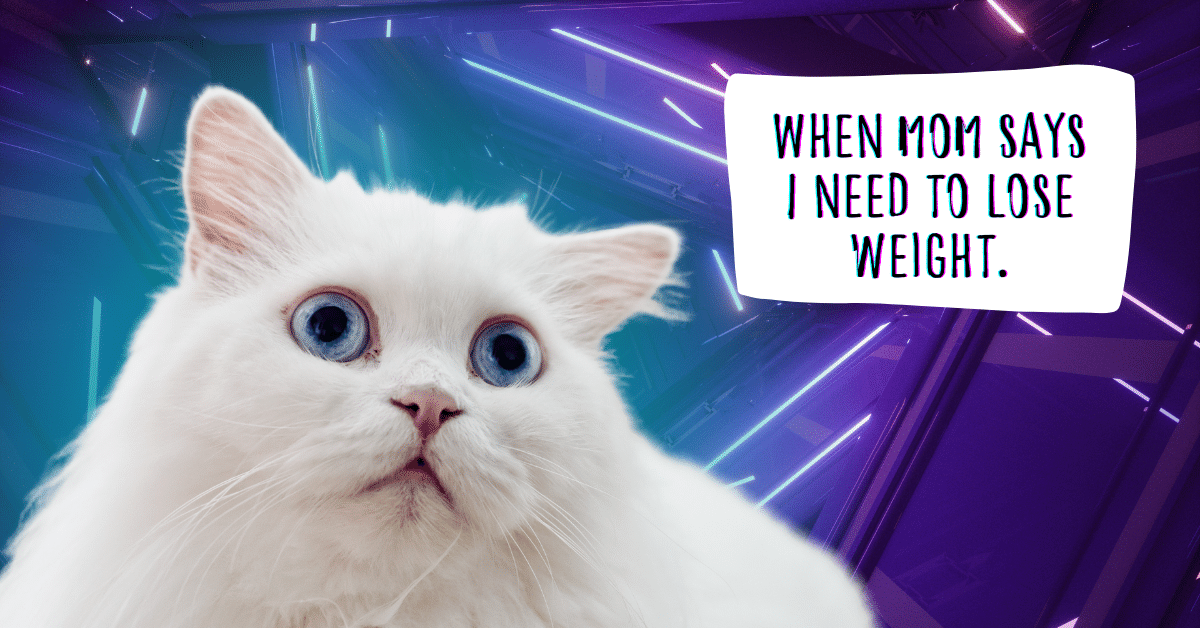You love your furry family – and that also means you love to spoil them! Though extra treats and lots of cozy relaxation time make for a happy pet, they don’t always make for a healthy one. Whether your four-legged bestie is already a little chunky or you’re trying to avoid future weight-gain, use these simple tips to keep your dog or cat trim and in better health!
1. Monitor meal size
Just like humans, pets’ metabolisms differ with age. While younger pets may need more food to fuel their growing and active bodies, older furry friends may require a smaller meal-size to account for less activity. Most pet food packaging includes recommended portions based on age and size. Before your pet’s next chow time, double check to see if you may be over feeding. Please consult your veterinarian first before adjusting your pet’s portion size, or if you’re unsure what their portion size should be.
Don’t forget! Too little food is just as harmful as too much. Be sure you’re providing your furry bestie enough food to keep them energized – never resort to starvation!
2. Prioritize play and exercise
While it’s good for your dog or cat to have plenty of relaxation, too much lounging can result in rapid weight gain. Just like with your own exercise routine, prioritize time for regular walks and playtime with your pet. When planning exercise, be sure it’s within your pet’s comfort zone. Older pets, puppies, and kittens tire quickly and can become exhausted with too much activity. Additionally, pay attention to the weather during pet playtime. Steamy summer temps and frigid winter weather can pose a threat to your four-legged friend’s health; always have a plan to keep your dog or cat active indoors.
3. Invest in the right food
Food portions aren’t the only thing that can impact your pet’s weight. Just like your human family, your pet’s dietary needs are unique to their own body! Often, generic foods (and many big-name pet food brands) do not offer the complete nutritional value pets need to maintain a healthy metabolism, resulting in reduced energy and weight gain. Many pet food manufacturers offer “sloppy seconds” as food sources (i.e. ingredients that are not human grade). When shopping around, check for brands that offer “nutritionally complete” food, have slim to zero recalls, and include human grade ingredients.
If you’re feeling unsure about which food is right for your pet(s), your vet can offer the best recommendations.
4. Watch out for sneaky snackers
If you have multiple pets in your home, there’s a good chance they may sneak a bite from their furry sibling’s bowl. Over time, these extra helpings can result in major weight gain (and an upset tummy if your pets have different food). If possible, try to feed your pets in different areas of the home or stagger their meals to avoid pre- or post-meal snacks. If you have a pet who leaves leftovers, keep their bowl away from wandering noses (especially doggos with a penchant for cat food).
Tip for multi-pet parents: Have you heard of the SureFeed – Microchip Pet Feeder? Add this to the top of your pet’s wish list!
5. Keep an eye on the treats
Few things make your doggo or feline friend happier than a tail-wagging treat (which is why they sometimes enjoy more than they should). Just like human junk food, treats are often packed with not-so-healthy ingredients that can cause rapid weight gain. While there’s nothing wrong with an occasional reward, try to avoid overdoing treats.
However, if you’re like most pet parents and can’t help but spoil your dog or cat at every opportunity, consider swapping out fattening treats with healthy whole foods like raw carrots and blueberries.
Be careful! Not all vegetables and fruits are ok for pets to eat; in fact, some can be harmful to their health. Before handing out fresh veggies, consult with your vet to ensure they’re safe.
6. Visit your vet
Though helping your pet shed a few pounds (or avoiding weight gain before it happens) is usually a matter of healthy eating and exercise, regular check ups are also a crucial component. Vets can help you start healthy routines that are beneficial to the unique physiology of your pet.
Remember, while weight loss is normally a good thing, a rapid decline in body fat is sometimes unhealthy – just like with us humans! Your vet can provide tools, resources, and insights that will help your pet safely lose weight without starvation or over-exhaustion.
At Companion Protect®, it’s our mission to help more pets live the happy, healthy lives they deserve! In addition to protecting your furry family from unexpected accidents and injuries, we’re also proud to offer coverage that helps pet parents afford prescription pet food! Fetch a quick quote today!
 WILSON WEAVER
WILSON WEAVER
Copywriter
Wilson has written for brands in the tech, e-commerce, construction, health, and finance industries. In his free time, he enjoys cooking for friends and family, spoiling his dog-daughter (Penny), painting, and playing music with friends. And speaking of food, his favorite meal is his mom’s pot roast and mashed potatoes!


